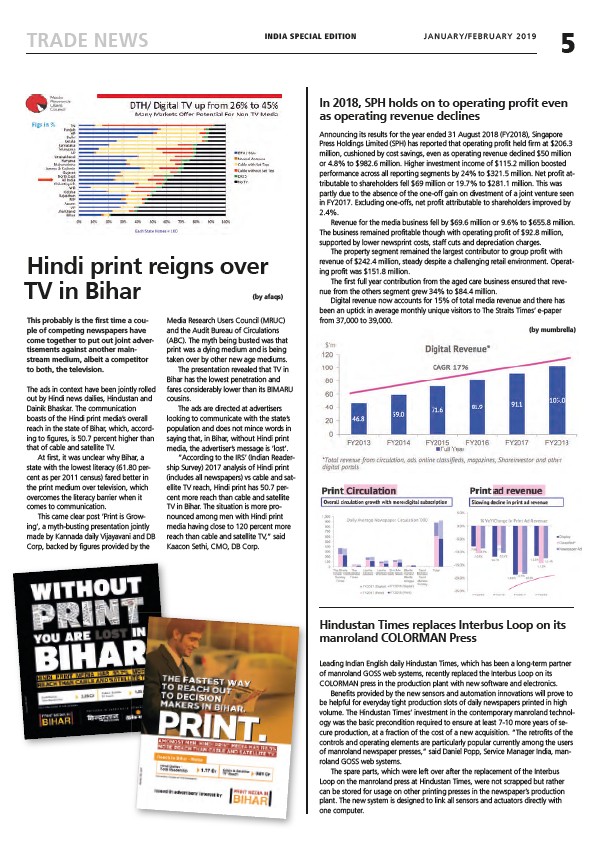
TRADE NEWS INDIA SPECIAL EDITION JANUARY/FEBRUARY 2019
5
Hindi print reigns over
TV in Bihar (by afaqs)
This probably is the first time a couple
of competing newspapers have
come together to put out joint advertisements
against another mainstream
medium, albeit a competitor
to both, the television.
The ads in context have been jointly rolled
out by Hindi news dailies, Hindustan and
Dainik Bhaskar. The communication
boasts of the Hindi print media’s overall
reach in the state of Bihar, which, according
to figures, is 50.7 percent higher than
that of cable and satellite TV.
At first, it was unclear why Bihar, a
state with the lowest literacy (61.80 percent
as per 2011 census) fared better in
the print medium over television, which
overcomes the literacy barrier when it
comes to communication.
This came clear post ‘Print is Growing’,
a myth-busting presentation jointly
made by Kannada daily Vijayavani and DB
Corp, backed by figures provided by the
Media Research Users Council (MRUC)
and the Audit Bureau of Circulations
(ABC). The myth being busted was that
print was a dying medium and is being
taken over by other new age mediums.
The presentation revealed that TV in
Bihar has the lowest penetration and
fares considerably lower than its BIMARU
cousins.
The ads are directed at advertisers
looking to communicate with the state’s
population and does not mince words in
saying that, in Bihar, without Hindi print
media, the advertiser’s message is ‘lost’.
“According to the IRS’ (Indian Readership
Survey) 2017 analysis of Hindi print
(includes all newspapers) vs cable and satellite
TV reach, Hindi print has 50.7 percent
more reach than cable and satellite
TV in Bihar. The situation is more pronounced
among men with Hindi print
media having close to 120 percent more
reach than cable and satellite TV,” said
Kaacon Sethi, CMO, DB Corp.
In 2018, SPH holds on to operating profit even
as operating revenue declines
Announcing its results for the year ended 31 August 2018 (FY2018), Singapore
Press Holdings Limited (SPH) has reported that operating profit held firm at $206.3
million, cushioned by cost savings, even as operating revenue declined $50 million
or 4.8% to $982.6 million. Higher investment income of $115.2 million boosted
performance across all reporting segments by 24% to $321.5 million. Net profit attributable
to shareholders fell $69 million or 19.7% to $281.1 million. This was
partly due to the absence of the one-off gain on divestment of a joint venture seen
in FY2017. Excluding one-offs, net profit attributable to shareholders improved by
2.4%.
Revenue for the media business fell by $69.6 million or 9.6% to $655.8 million.
The business remained profitable though with operating profit of $92.8 million,
supported by lower newsprint costs, staff cuts and depreciation charges.
The property segment remained the largest contributor to group profit with
revenue of $242.4 million, steady despite a challenging retail environment. Operating
profit was $151.8 million.
The first full year contribution from the aged care business ensured that revenue
from the others segment grew 34% to $84.4 million.
Digital revenue now accounts for 15% of total media revenue and there has
been an uptick in average monthly unique visitors to The Straits Times’ e-paper
from 37,000 to 39,000.
(by mumbrella)
Hindustan Times replaces Interbus Loop on its
manroland COLORMAN Press
Leading Indian English daily Hindustan Times, which has been a long-term partner
of manroland GOSS web systems, recently replaced the Interbus Loop on its
COLORMAN press in the production plant with new software and electronics.
Benefits provided by the new sensors and automation innovations will prove to
be helpful for everyday tight production slots of daily newspapers printed in high
volume. The Hindustan Times’ investment in the contemporary manroland technology
was the basic precondition required to ensure at least 7-10 more years of secure
production, at a fraction of the cost of a new acquisition. “The retrofits of the
controls and operating elements are particularly popular currently among the users
of manroland newspaper presses,” said Daniel Popp, Service Manager India, manroland
GOSS web systems.
The spare parts, which were left over after the replacement of the Interbus
Loop on the manroland press at Hindustan Times, were not scrapped but rather
can be stored for usage on other printing presses in the newspaper’s production
plant. The new system is designed to link all sensors and actuators directly with
one computer.